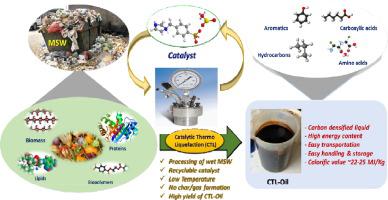Waste Management ( IF 8.1 ) Pub Date : 2020-06-16 , DOI: 10.1016/j.wasman.2020.06.001 Shravan Sreenivasan 1 , Tejas M Ukarde 1 , Preeti H Pandey 1 , Hitesh S Pawar 1

|
Continual increase in municipal solid waste (MSW) posing global environmental challenge which directed focus towards the waste to energy to achieve dual goal of waste minimization and energy generation. The present manuscript introducing Bronsted acid ionic liquids (BAILs) mediated Catalytic Thermo Liquefaction (CTL) process for conversion of MSW into carbon densified liquid (CTL-Oil) which can be used for multiple energy and fuel applications. BAILs with different counter ions were synthesized and tested for CTL of wet organic biodegradable MSW. The exploration of BAILs provides significant benefits in terms of operating conditions (120 °C, 90 min) with zero char and gases. Of the synthesized catalysts [Benz-SO3HIm]+[H2PO4]−,[Benz-SO3Him]+[HSO4]−,[Benz-SO3HIm]+[TsO]−and [BenzSO3HIm]+[TfO]−, BAIL with [HSO4]−counter ion showed a profound effect on CTL. The intensified CTL process resulted in > 85% MSW conversion with > 80% yield of CTL-Oil without any char and gas formation. Use of BAILs assisted the ease of dissolution and hydrolysis of biomass to produce CTL-Oil via hydrolysis, condensation, cyclization and dehydration reactions. The plausible mechanism for CTL has been proposed. The physicochemical analysis of CTL-Oil was conducted by using elemental analysis, Bomb calorimeter, GC–MS and ATR-FTIR. It was found that the CTL-Oil was rich source of C (48–55%), H (6–8%), O (30–41%) containing compounds such as long-chain hydrocarbons, carboxylic acids, heterocyclic compounds, aldehydes, ketones and esters, etc. Furthermore, the calorific value of CTL-Oil was found to be 20–23 MJ/kg, thus it can be explored for multiple energy and fuel applications. However, the CTL process also adds several environmental and process economic benefits over the conventional waste liquefaction/disposal processes.
中文翻译:

BAIL介导的催化热液化(CTL)工艺将市政固体废物转化为碳致密化液体(CTL-Oil)。
不断增加的城市固体废物(MSW)构成了全球环境挑战,这使人们将关注点从废物转化为能源,从而实现了废物最小化和能源生产的双重目标。本手稿介绍了布朗斯台德酸性离子液体(BAIL)介导的催化热液化(CTL)工艺,用于将MSW转化为碳致密化液体(CTL-Oil),可用于多种能源和燃料应用。合成了具有不同抗衡离子的BAIL,并测试了湿有机生物降解垃圾的CTL。在零碳和零气体的工作条件(120°C,90分钟)下,BAIL的探索具有明显的优势。在合成的催化剂中[Benz-SO 3 HIm] + [H 2 PO 4 ]-,[Benz-SO 3 Him] + [HSO 4 ] - , [Benz-SO 3 HIm] + [TsO] -和[BenzSO 3 HIm] + [TfO] -,带[HSO 4 ] -的燃料抗衡离子对CTL具有深远的影响。强化的CTL工艺导致MSW转化率> 85%,CTL油的收率> 80%,没有任何焦炭和气体形成。使用BAIL有助于通过水解,缩合,环化和脱水反应使生物质易于溶解和水解以生产CTL油。已经提出了CTL的合理机制。通过使用元素分析,炸弹量热仪,GC-MS和ATR-FTIR进行了CTL油的理化分析。研究发现,CTL油是富含C(48-55%),H(6-8%),O(30-41%)的化合物,例如长链烃,羧酸,杂环化合物,醛,酮和酯等。此外,发现CTL油的热值为20-23 MJ / kg,因此可以探索它在多种能源和燃料应用中的应用。但是,与传统的废物液化/处置过程相比,CTL过程还增加了一些环境和过程经济利益。


























 京公网安备 11010802027423号
京公网安备 11010802027423号